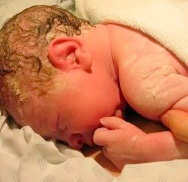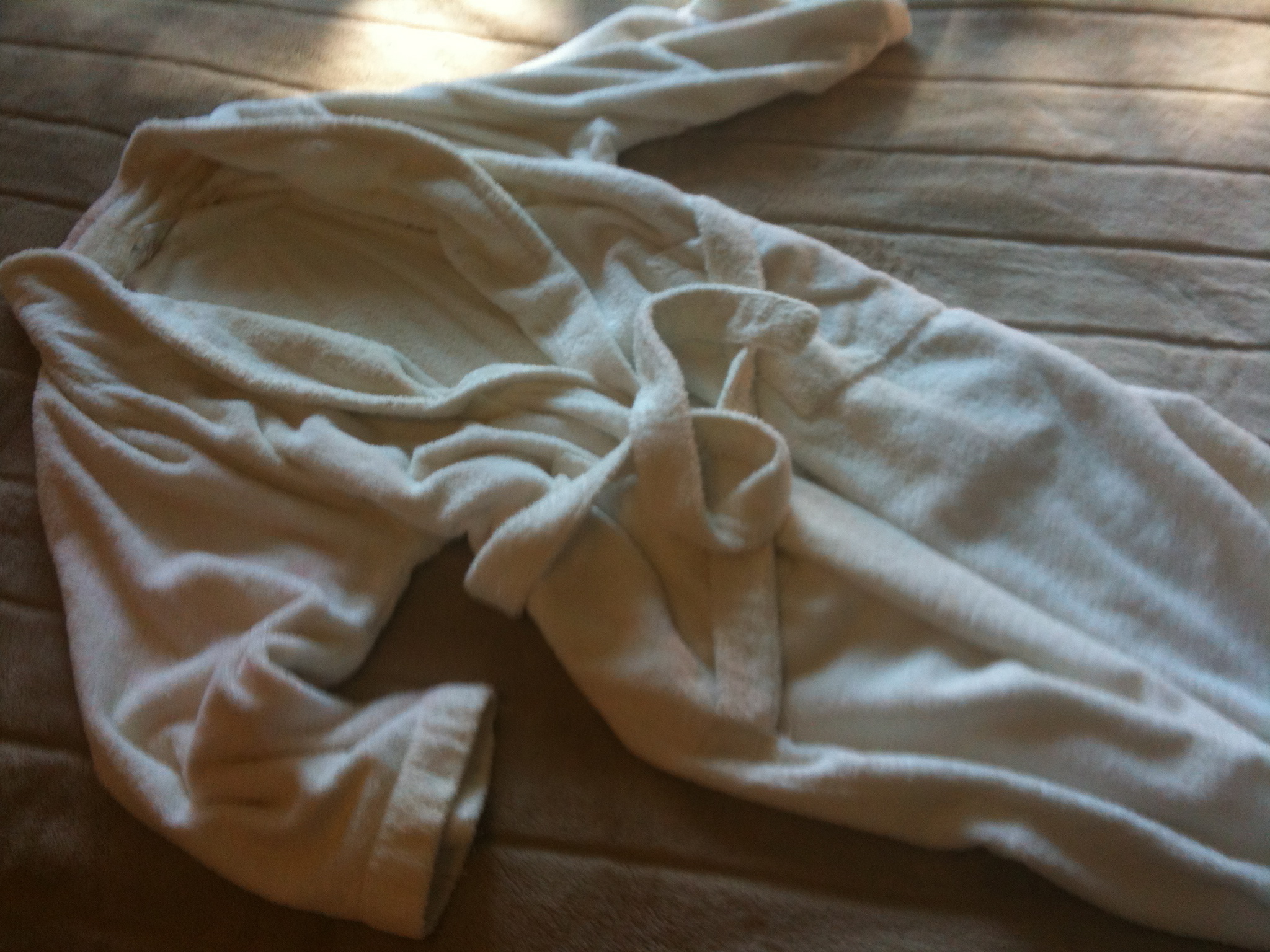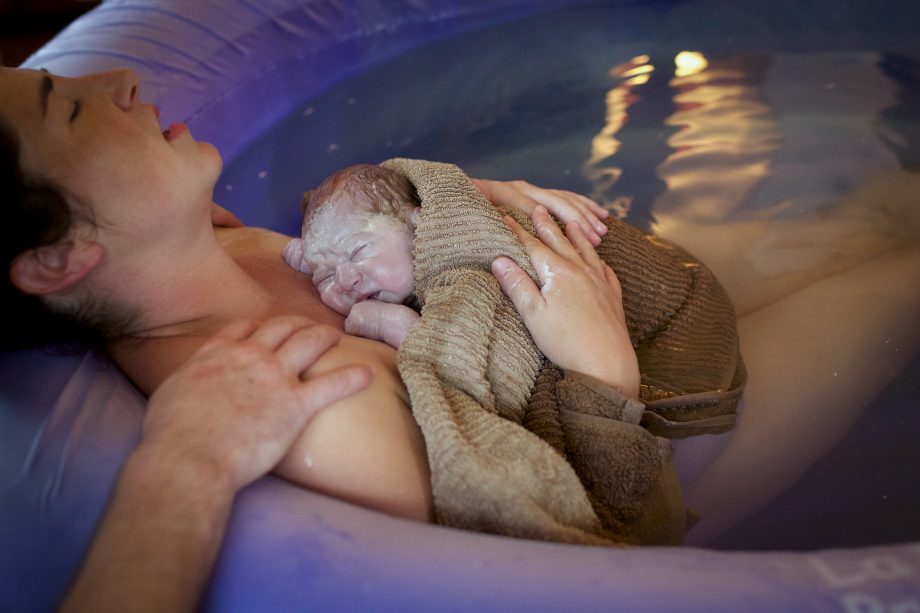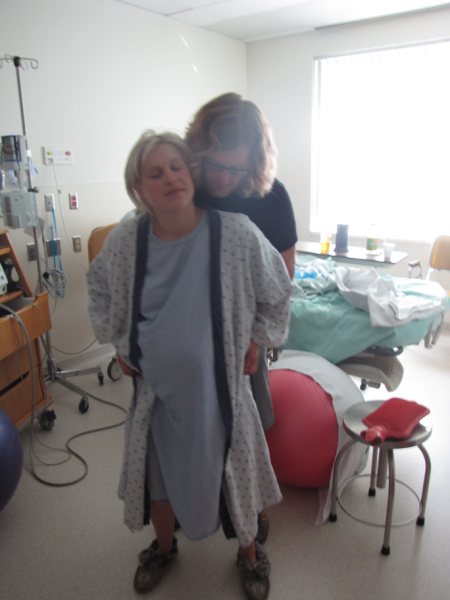
Here are several abstracts on the antibacterial properties of vernix. There’s a good reason why babies should not be bathed right away after birth.
The power of vernix is truly astounding. Its main benefits are its various antimicrobial properties, which help protect a newborn against a wide variety of infections. A secondary benefit is that vernix is highly moisturizing. To such a degree that many cosmetic companies have researched it.
I posted this blog, because sometimes hospitals routinely wash this stuff away. And while, I certainly understand the universal precautions for hospital personnel; if you wouldn’t touch a mom’s vaginal fluids without gloves, then it makes sense you shouldn’t touch the baby who just came from her vagina without gloves either. However the benefits of vernix for infants are too important to ignore.
If you consider the drug resistant staph sometimes found in hospitals, perhaps parents would prefer that hospital personnel wear gloves for the protection of the baby! One parent who was a nurse mentioned that in class one day, and it made perfect sense to me.
This list of research is by no mean conclusive, but it does represent a significant portion and offers a clear picture of the benefit of vernix.
Marie
*********************************
Antimicrobial Properties of Amniotic Fluid and Vernix Caseosa Are Similar to Those Found in Breastmilk
Akinbi, H. T., Narendran, V., Pass, A. K., Markart, P., & Hoath, S. B.
(2004). Host defense proteins in vernix caseosa and amniotic fluid.
American Journal of Obstetrics and Gynecology, 191 (6), 2090-2096.
Summary: In this study, researchers analyzed samples of amniotic fluid and vernix caseosa (vernix) from healthy, term gestations to determine the immune properties of these substances. Participants were pregnant women admitted for elective cesarean section after 37 weeks gestation with no prior labor and no signs of chorioamnionitis (intrauterine infection). Women with a history of prenatal fever or premature rupture of membranes, or who received steroids prenatally or antibiotics during delivery were excluded, as were women whose babies passed meconium in utero, had congenital malformations, or required prolonged resuscitation after birth. Amniotic fluid was obtained by amniocentesis to determine fetal lung maturity prior to elective delivery. Vernix was gently scraped from the newborn’s skin with a sterile implement immediately following delivery. There were 10 samples of amniotic fluid and 25 samples of vernix obtained.
Tests (Western analysis and immunochemistry) revealed that lysozyme, lactoferrin, human neutrophil peptides 1-3 and secretory leukocyte protease inhibitor were present in the amniotic fluid samples and in organized granules embedded in the vernix samples. These immune substances were tested using antimicrobial growth inhibition assays and found to be effective in inhibiting the growth of common perinatal pathogens, including group B Streptococcus, K pneumoniae, L monocytogenes, C albicans, and E coli.
The authors point out that the innate immune proteins found in vernix and amniotic fluid are similar to those found in breast milk. As the baby prepares for extrauterine life, pulmonary surfactant (a substance produced by the maturing fetal lungs) increases in the amniotic fluid, resulting in the detachment of vernix from the skin. The vernix mixes with the amniotic fluid and is swallowed by the growing fetus. Given the antimicrobial properties of this mixture, the authors conclude that there is therefore “considerable functional and structural synergism between the prenatal biology of vernix caseosa and the postnatal biology of breast milk.” They also suggest that better understanding of these innate host defenses may prove useful in preventing and treating intrauterine infection.
Significance for Normal Birth: It is well understood that routine artificial rupture of membranes increases the likelihood of intrauterine infection because it eliminates the physical barrier (the amniotic sac) between the baby and the mother’s vaginal flora. This study suggests an additional mechanism for the prevention of infection when the membranes remain intact: a baby that is bathed in amniotic fluid benefits from antimicrobial proteins that are found in the fluid and in vernix caseosa.
The results of this study also call into question the routine use of some newborn procedures. Early bathing of the baby removes vernix, which contains antimicrobial proteins that are active against group B streptococcus and E. coli. Delaying the bath and keeping the newborn together with his or her mother until breastfeeding is established may prevent some cases of devastating infections caused by these bacteria.
The fact that preterm babies tend to have more vernix than babies born at or after 40 weeks might mean that healthy, stable preterm babies derive even greater benefit from staying with their mothers during the immediate newborn period.
Finally, this study illustrates how the normal physiology of pregnancy and fetal development is part of a continuum that extends beyond birth to the newborn period. The immunologic similarities between amniotic fluid, vernix and breast milk provide further evidence that successful initiation of breastfeeding is a critical part of the process of normal birth.
*********************************
Antimicrobial polypeptides of human vernix caseosa and amniotic fluid: implications for newborn innate defense.
Yoshio H, Tollin M, Gudmundsson GH, Lagercrantz H, Jornvall H, Marchini G, Agerberth B.
Department of Woman and Child Health, Karolinska Institutet, Stockholm, Sweden.
http://www.ncbi.nlm.nih.gov/sites/entrez?cmd=Retrieve&db=PubMed&list_uids=12538777&dopt=Abstract
Antimicrobial peptides/proteins are widespread in nature and play a critical role in host defense. To investigate whether these components contribute to surface protection of newborns at birth, we have characterized antimicrobial polypeptides in vernix caseosa (vernix) and amniotic fluid (AF). Concentrated peptide/protein extracts were obtained from 11 samples of vernix and six samples of AF and analyzed for antimicrobial activity using an inhibition zone assay. Proteins/peptides in all vernix extracts exhibited strong antibacterial activity against Bacillus megaterium (strain Bm11), in addition to antifungal activity against Candida albicans, whereas AF- derived proteins/peptides showed only the former activity. Fractions obtained after separation by reverse-phase HPLC exhibited antibacterial activity, with the most pronounced activity in a fraction containing alpha-defensins (HNP1-3). The presence of HNP1-3 was proved by dot blot analysis and confirmed by mass spectrometry.
Lysozyme and ubiquitin were identified by sequence analysis in two fractions with antibacterial activity. Fractions of vernix and AF were also positive for LL-37 with dot blot and Western blot analyses, and one fraction apparently contained an extended form of LL-37. Interestingly, psoriasin, a calcium-binding protein that is up- regulated in psoriatic skin and was found recently to exhibit antimicrobial activity, was characterized in the vernix extract. The presence of all of these antimicrobial polypeptides in vernix suggests that they are important for surface defense and may have an active biologic role against microbial invasion at birth.
Publication Types: Research Support, Non-U.S. Gov’t PMID: 12538777 [PubMed – indexed for MEDLINE]
*********************************
Skin Sciences Institute Study Key to Baby-Like Skin
http://www.cincinnatichildrens.org/about/news/release/2003/5-vernix.htm
Tuesday, May 06, 2003
CINCINNATI — For nine months before birth, infants soak in a watery, urine-filled environment. Just hours after birth, however, they have near-perfect skin. How is it that nature enables infants to develop ideal skin in such seemingly unsuitable surroundings?
A new study by researchers at the Skin Sciences Institute of Cincinnati Children’s Hospital Medical Center shows that the answer may be vernix — the white, cheesy substance that coats infants for weeks before they are born, then is wiped off and discarded immediately after birth. If they’re right, the health care implications for newborns and adults could be remarkable.
The study, presented May 6 at the annual meeting of the Pediatric Academic Societies in Seattle, shows that newborn skin with vernix left intact “is more hydrated, less scaly, and undergoes a more rapid decrease in pH than with vernix removed,” says Marty Visscher, PhD, executive director of the Skin Sciences Institute and the study’s main author. “These beneficial effects of vernix suggest that it should be left intact at birth.”
Vernix is a complex mixture of lipids (fats), proteins and water. Babies born at 32 to 33 weeks are covered with the material. Those who are born full term have already lost a good portion of it. The researchers studied full-term infants, half of whom had vernix wiped off and half left intact on the surface of the skin. Skin hydration, moisture accumulation rate, skin pH and visual dryness were measured at one, four and 24 hours after birth.
Skin Sciences Institute researchers have been studying vernix for several years and found that it is not only a moisturizer but also a wound healer, cleanser, anti-infective and antioxidant. Cincinnati Children’s has obtained four patents on vernix technology and hopes to formulate a synthetic equivalent that could be used in a variety of ways: as a film on products ranging from diapers to wound dressings; as a replacement for vernix in low-birthweight, premature infants who are born before vernix develops at about 27 weeks; as a cream or lotion for topical needs; and as a delivery system for other medications.
“We view the production of vernix as analogous to infant formula as a substitute for milk,” says Dr. Visscher. “Nature has figured out how to make it. Long term, we hope to be able to mass produce a synthetic equivalent. There is nothing out there now to take care of these preterm babies, and the list of other applications for vernix is endless.”
The Skin Sciences Institute views infant skin as ideal skin and focuses on the skin as a primary care interface — a biological spacesuit that separates outer from inner space. “Skin is the largest organ in the body, yet it’s often treated as insignificant,” says Steven Hoath, MD, a neonatologist, medical director of the Skin Sciences Institute and co-author of the study. “You can’t deliver medical care in the home or hospital without paying attention to this interface, and it has a disproportionate impact on patient satisfaction. People assume you can transplant a liver, but if you can’t pull leads off without hurting them, you’re not providing good care.”
The Skin Sciences Institute has established collaborative relationships with major companies involved in skin care as well as skin barrier structure and function, including the Procter & Gamble Co., the Andrew Jergens Company, Kao Corporation, GOJO Industries, Coloplast Corporation, Kenabo, Becton Dickinson, Vyteris, NOVA Technology Corporation, 3M, and W. L. Gore Industries.
*********************************
The Biology of Vernix Caseosa
http://www.blackwell-synergy.com/doi…4.2006.00338.x
S. B. Hoath, W. L. Pickens and M. O. Visscher – International Journal of Cosmetic Science, Volume 28 Page 319 – October 2006
doi:10.1111/j.1467-2494.2006.00338.xVolume 28 Issue 5
“Postnatally, vernix is simultaneously a cleanser, a moisturizer, an anti-infective, and an anti-oxidant. Vernix facilitates acid mantle development and supports normal bacterial colonization. Its hydrated cellular structure and unusual lipid composition provide a ‘best’ solution for the needs of the foetus and newborn”
*********************************
Vernix caseosa as a multi-component defence system based on polypeptides, lipids and their interactions
http://www.springerlink.com/content/q31860t243485552/
M. Tollin, G. Bergsson, Y. Kai-Larsen, J. Lengqvist, J. Sjövall, W. Griffiths, G. V. Skúladóttir, Á. Haraldsson, H. Jörnvall1, G. H. Gudmundsson and B. Agerberth, Journal Cellular and Molecular Life Sciences (CMLS) Volume 62, Numbers 19-20 / October, 2005 pp 2390-2399
“protective functions to vernix such as antifungal activity, opsonizing capacity, protease inhibition and parasite inactivation…In conclusion, vernix is a balanced cream of compounds involved in host defence, protecting the foetus and newborn against infection.”
*********************************
A novel role for vernix caseosa as a skin cleanser
http://www.ncbi.nlm.nih.gov/entrez/q…&itool=toolbar
PMID: 15334030, Moraille R, Pickens WL, Visscher MO, Hoath SB. Biol Neonate. 2005;87(1):8-14. Epub 2004 Aug 27.
“a role for vernix caseosa as a skin cleanser. Previous views of vernix as a soil or skin contaminant at birth need to be reevaluated.”
If you enjoyed reading this article, you might also like these two posts.
Sometimes this question of what to wear in labour comes up in my hypnobirthing class. I often suggest that women watch to see what women wore in the videos – hospital gowns, bra tops, towels, big t-shirts, bath robes, nothing at all, or whatever appeals at the time… And when I think back on my own three labours, I realized that I wore all of the clothing on the above list at various times. Keep Reading
Are You Ready for Baby?
If you are close to your due date, chances are that someone or perhaps everyone seems to be asking you this question. But how really does anyone prepare for a new baby? To me preparing for a new baby is much like getting ready for a trip to a foreign country. Keep Reading







41 thoughts on “Benefits of Vernix – it’s amazing stuff (and here’s the scientific research to prove it)”
I read your articles on antimicrobial effect of vernix caseosa and amniotic fluid with keen interest and was really impressed. I wil great if more articles on this subject matter wil sent to me. Thank u.
I had already decided to hold off on waiting to give my baby boy a bath once he is born (doing a home birth), the question is how long should I hold it off? Hours, a day, a week? I’m not sure of this answer . . . if you have some insight, please let me know. Thanks!
Most of the vernix is absorbed into the baby’s skin within the first 24 hours, so giving baby a bath anytime after that first day would probably be just fine. Just remember to warm up the room first. The chances that your baby will like the experience increase greatly when the room is warm. 🙂
Vernix may have some antibacterail properties, and if it so it perhaps natures way to fight the harmful bacterias or virus that may be present in the mothers vaginal canal. So I would recommend to leave the vernix on only if you don’t have immediate access to clean water. But clean water fight infection better than vernix. A bath as soon as possible is mandatory on babies born of known HIV mothers. Other babies that may definitively benefit from water bath include infants born to GBS positive mothers, Herpes, Chlamydia and hepatitis. If you still decided no to bathe ypour baby, please do not allow other young children to touch the baby until the baby has been fully bath
Hi Jaiver,
I’m not sure that water would be enough. I don’t believe there is any research that shows that water would fight infection better than vernix. Do you know of any such research? I’m assuming that with HIV moms, they would wash the baby with a soap solution and not just water, but I haven’t yet worked with any HIV moms, so I’m not sure of the recommendations in that case.
Had two babies at home and never washed the vernix off due to advice of my midwife. They were perfectly fine and healthy. You can tell when it is absorbed into the skin, about a day later. God’s design. 🙂
I attended a family member’s birth yesterday as her Doula and was told by a nicu nurse of 35 years that she has never heard that vernix holds any benefit to baby and must be removed so the nurses won’t have to waste time with gloves before they handle the newborn. Thank you very much for posting this. I can’t wait to share this information.
It would be really great if you could share the research with the nurses at the hospital where you doula. Evidence based care is the new buzz word in health care. So if you prove it through research then the norms at the hospital with change. If you can meet with the nurse educator or nurse manager for labour and birth and share your experience (without naming names) and the research, then she might be able to make vernix one of the topics of study for the nurses during the next in-service or professional development day. I wish you well creating positive change in your area!
I am a labour and delivery nurse and the policy at my hospital is to wait as long as possible for the first bath to allow baby to benefit from the protective vernix. There are more important things like skin to skin and breastfeeding that take priority as well!
My third child was born (at 38 wks 3 days) with quite a bit on him, that surprised me because my other 2 had none (both 40 wks), I had a water birth so maybe a bit came off but we didn’t bathe him for a few days after that. (I had a home birth)
Hi there… thanks for your response. Usually the amount of vernix decreases with the longer gestation is. So babies born at 38 weeks will generally have more than babies born at 42 weeks. So your experience is quite normal. And it’s likely that your older too had a little bit, but likely so light a covering that is was unnoticed. 🙂
Good to know! Even thought my babies were bathed a few hours after birth in the hospital, the ones that had a good amount of vernix still on them they instructed me to leave in place! She showed me the vernix in the creases of baby’s skin and said to leave that alone and let the skin absorbe it because it’s so good for the baby’s skin. I’m so glad they did that! This baby will be a homebirth baby so he won’t have a bath so soon. Thanks for the info!
Very interesting article! But I have some questions:
1) Will a water birth wash off the vernix?
2) Once baby is born, should the vernix be rubbed into the skin or just left on the body as is?
Hi Krystal – Thanks for reading my blog. You have 2 good questions.
1. No. Vernix doesn’t wash off that easily. It must be washed off by rubbing and usually the use of some soap. It has fat in it that’s why it is so moisturizing and why it isn’t so affected by water. It’s on the baby while they are inside you and are continuously surrounded by water. Now as an aside, when you near your due date your baby will release hormones which will get some of the vernix to breakdown into the waters. This is actually as the amniotic fluid then has some of the qualities of the vernix. And on a personal note, I had a water birth and no the vernix wasn’t affected. Sometimes there will be so much vernix you can really see it. It’s white. Other times it will be so thin that you might not notice it.
2. After baby is born just let it absorb into the skin naturally. The whole process usually takes 24 hours max. If it’s really thick some will rub off on the blanket and that’s fine.
Just found your site – love it! I just shared this post on the Raising Natural Kids Facebook page! Please check out mine when you get a chance! http://www.raisingnaturalkids.com
Im pregnant with 3rd and we will be delivering at a hospital… So my question is
After birth should i just keep baby on me and immediatley initate nursing?
Keep baby skin to skin?
Should i wrap baby in blanket after birth or just skin to skin to keep warm and keep vernix intact?
Also if my child passes meconium at birth (my 1st 2 kids passed meconium as they came out) should the child be given bath to get off that meconium ? Or just still leave them be with vernix intact?
Thanks
Hi Nikki – yup do this – after birth just keep baby on you and immediately initiate nursing. If there is meconium they will wash or wipe if off first. It washes off easier than vernix. So the vernix is stay and the meconium will go. I would also suggest doing some visualization work around seeing this baby coming out clear.. (without the meconium) and having a really good constant oxygen supply by visualizing the cord being really really thick and strong. All the best! Marie (as an aside Juice Plus really helps with create better umbilical cords. Let me know if you’d like more information about that.)
When our second baby was born, we refused the bath. I knew about the importance of vernix, but of course didn’t have any research to back it up. Hospital staff labeled our baby’s crib as ‘bio hazard’ and all the nurses were required to wear gloves. Well, fine by me! He only got his first bath 1 week after he was born :).
thanks for sharing
Can this data be used to support a delayed C-section? I am over 38 and they said that with new data, older mothers should have their c-section at 38 weeks to prevent complications from placental abruption. I am healthy, have perfect blood pressure, no adema, all my tests are great and the non-stress test’s on the baby are perfect too. The midwife nurse who did my stress test yesterday could sense that I wanted to ask her some questions. We spoke about this issue. My first child (5 1/2yr old son) was taken via c-section at 39 weeks. I mentioned to her that he was totally white/grey looking when they took him from my womb. He also had issues with jaundice. She said that even by c-section a baby that was that covered in vernix was likely not full term. They keep telling me that 37 weeks is considered full-term. She also looked as my first ultrasound at like 9-10 weeks. According to that u/s, the due date is more like June 28th, not June 24th like they are saying the date is (they are using the 5-day blastocyst and day of implantation as their guide on the due date). So, with that backstory, I am wondering if citing to them that our son even at 39 weeks was possibly not as developed at they thought…and that it could be true for this new little one (also a boy). I am trying to present a rational case to delay the c-section by a week in order to give him more time in the womb.
Also, I will be asking them to leave the vernix on. But one question, is the vernix a bio-hazard? Myself, my husband and our 5 1/2 yr old son will be wanting to touch his cheeks and kiss him. Any thoughts? Also with a section, they take the baby away to do vitals, etc… so he would not begin breastfeeding right away.
Any insights would be a total blessing! Thanks!
Hi Dee,
I think you could definitely argue to delay the c-section until 40 weeks. Where are you? I’m in Saskatchewan, Canada and c-sections at 38 weeks in “older” moms is not routine here. It does happen but there are usually mitigating medical issues which you don’t seem to have. And yes, I agree with what the nurse-midwife mentioned about all of vernix being a sign that the baby is gestationally younger however it’s not conclusive proof. It’s more of a generalization so I don’t believe you could use it to support a delayed C-section. There is much strong research for delayed c-sections such as brain development, jaundice, breastfeeding issues… you can search the benefits of being full term or problems with early term babies. Here is an article to get you started. http://www.medicalnewstoday.com/articles/242496.php And you can definitely find lots more along those lines.
With any intervention, the medical care provider (doctor or midwife) is trying to balance risk and benefit. Right now your care provider sees the risk of placental abruption is greater than the benefit of a longer gestation for baby. I would simply get a few more options! See if other care providers believe the same thing or think differently.
As for the bio-hazard… nope that’s not an issue. Baby won’t be passing through your vaginal canal. So Kiss away! 🙂 As aside, this isn’t really an issue with vaginal births either – not unless there was an outbreak in the vagina with a venereal disease… but with healthy moms it is fine.
Marie
Is it safe to delay the bath if you have tested positive for HPV? (HPV no treatment required-not cancer or wart causing)
Hi Sky,
I’m not familiar with HPV so I would suggest that you consult with a few doctors and get a few options. Then choose the option that is the gentlest for you and baby.
I wish you all the best.
Marie
I love your response here. There are usually ways to make a necessary intervention gentler if you take the time to think about it and plan.
This is a great article and plan to share it on my facebook page.
This is really interesting, but I am curious if newborn babies getting staph (or other skin) infections is really a problem? Does this happen often?
I got a staph infection at birth and it is very likely that I was washed (being the 1970s). It still happens.
I am a mother of three and my last two were born natural and at home, I didn’t bathe them for days after they were born. I didn’t have all the research behind me but instinctively the scrubbing of my first child in the hospital did not seem like the right thing to do and I regret that she was taken from her mothers arms so they could do this.
Absolutely… Leave the Baby’s Vernix alone, they made it, they need it. With LOVE, Ibu Robin Lim
I love learning new stuff like this. Amazing how our bodies create something that is so useful and protective and our society has this weird thing about being clinically clean that we wash everything away. While my babies had their first bath within just a couple hours of being born, I appreciate learning this to pass onto other expectant moms who may inquire.
I’m a little confused here. Why not a gentle warm water bath or rinse off with either only warm water or possibly a few drops of mild baby shampoo to get rid of the blood, meconium, or other non desirable bacteria or potential viruses on the newborn. I agree, scrubbing a newborn clean is old school. Phisohex is out. But an initial wipe down with a towel for drying is often not enough to get the obvious stuff which adheres to the vernix. I think a gentle wipe off with warm bath with either only warm water or water with a spot of mild baby shampoo in it makes sense and after drying, keeps the baby warmer overall during the first 24 hours. A bath can be given that is very mild and cleans the newborn but leaves the vernix in place. Some newborns have a lot of blood mixed with the vernix in their hair. When this dries it is cold. After a water bath, Vernix will still be there but most of the undesireable blood, stool, meconium on the the surface, this undesirable debris will rinse away and Vernix will be left intact. Excess vernix left in the folds such as the armpits, and other folds of the skin, can make the baby cold.
We know the body only does evolution supporting functions and principles. The old ways knew this. Sadly in most of our recent intellectual evolution we have become superficial and detached from wisdom. Everyone needs to be re minded about that big picture. What looks good or bad to the aesthetic eye needs to be more deeply educated to true cause and reason. Vernix is but a small part of that picture, but a good starting place, along with all the other ‘fear from ignorance’ and many other modern day pressure based learning and teachings
Our son came out very “cheesy” at 39w4d…we did NOTHING but let it all absorb. Where the baby lay on my chest, my skin was SO soft and it absorbed into his skin fairly quickly. There was no other materials on the baby’s skin, so there was no reason for a bath with anything. Our son didn’t get a bath for maybe 10 days! With our new little one, due in the fall, we will be practicing the same thing!
Your site is absolutely wonderful. ION, retired RN, IBCLC
Reblogged this on I AM That, I am.